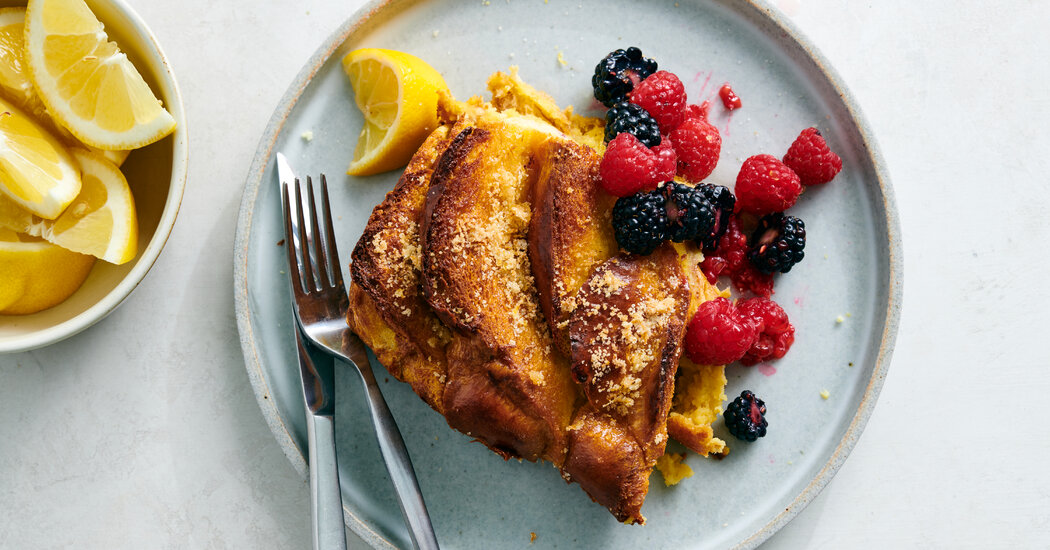Humans have been rehabilitating rock-hard, stale loaves into edible food since bread was first invented. But the recipe that has become irrevocably rooted in American breakfast culture is French toast.
Based on the French “pain perdu,” or lost bread, French toast is traditionally made from old, leftover slices softened in a mix of milk and eggs, then fried until golden and crisp on the outside and creamy inside.
While the dish may have originally been a way to rescue old bread, the costly milk, eggs and butter it calls for made it far from thrifty. In “The Oxford Companion to Food,” Alan Davidson writes that, although French toast is iconically represented as a strategy for using up stale bread, its expensive ingredients suggest it was “more frequently regarded as a delicacy.”
Mr. Davidson’s list of historical variations includes an ancient Roman example from Apicius (using wine and honey); its Anglo-Norman cousin (served with almond milk); and their Spanish relation, torrijas (adorned with syrup and cinnamon). I’ve seen (and created) modern iterations that include peanut butter and condensed milk, streusel crumbs and pears, pumpkin spice and pecans.
But no matter how many extravagant ingredients you lavish on your French toast, the best versions are still made from days-old bread — or at least bread that’s been dried out in the oven or toasted (which adds a nice grilled flavor). Spongy, fresh bread would dilute the egg mixture with its moisture, while dehydrated bread would more thirstily absorb the custard, swelling and plumping voluptuously. It may take longer to soak dry bread, but it’s worth the wait. Assembling everything the day before and sticking it in the fridge overnight ensures maximum absorption and makes your morning easier, too.
Most classic recipes call for frying the soaked slices, but I gave that up years ago. Why stand over the stove frying soggy bread in an undercaffeinated state when your oven can do all the work? Besides, while the oven is on, it’s easy to throw in a pan of bacon to cook at the same time. Baking won’t give you the crisp fried crust; I compensate with a sprinkle of sugar, which caramelizes and turns crunchy as it bakes.
I apply the sugar differently in these two new recipes, to distinct but equally delicious results. I created them for my YouTube cooking show, Shortcut vs. Showstopper, where I demonstrate two versions of classic recipes, one simple but still stunning, the other a more complex variation designed for the maximum wow factor.
For the simple French toast, baked on a sheet pan, I lay the soaked sliced bread on top of a layer of brown sugar and butter. As the bread bakes, the sugar turns into a glossy, candylike crust that snaps when your fork cuts through to the soft, vanilla-infused center.
The showstopper version, inspired by a cloudlike soufflé, features a lemon-scented sugar sprinkled on top. During baking, the sugar singes and darkens in spots, while the bread puffs and turns golden. A cross between bread pudding and a fancy soufflé, this makes the most elegant of brunch dishes.
Either recipe would be a perfect thing to serve on Mother’s Day.
As to what kind of bread to start with, it depends on what texture you’re going for. An egg-enriched bread like challah becomes caky, with a tender, tight crumb. Open-textured bread, like brioche or even croissants, capture more air and end up lighter and fluffier. Regular firm white bread (pain de mie) holds its shape and stays very moist after cooking, while crusty breads like sourdoughs and baguettes retain a pleasant and satisfying chew.
The possibilities are endless. In fact, the flexibility of the dish may be the secret of its staying power. With basic ingredients that you can adjust to suit your mood and keep interesting every time, it’s no wonder French toast never gets stale.
Follow New York Times Cooking on Instagram, Facebook, YouTube, TikTok and Pinterest. Get regular updates from New York Times Cooking, with recipe suggestions, cooking tips and shopping advice.







